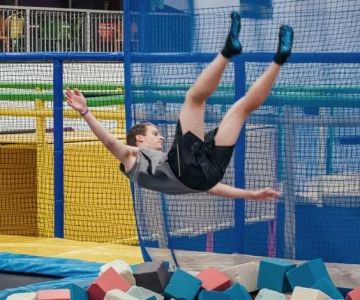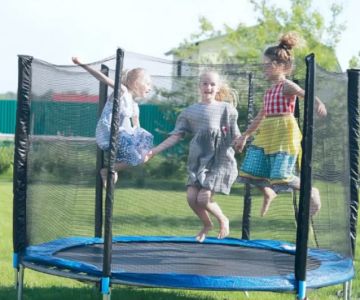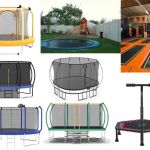- 1-Benefits-of-Trampolines-for-Kids-with-Autism
- 2-Sensory-Integration-and-Trampoline-Therapy
- 3-Motor-Skills-Development-through-Trampoline-Use
- 4-Practical-Examples-and-Real-Stories
- 5-Safety-Considerations-and-Guidelines
- 6-Where-to-Find-Specialized-Trampolines-and-Support
1. Understanding the Benefits of Trampolines for Kids with Autism
Trampolines offer a unique and engaging form of physical activity that can be especially beneficial for children with autism. They provide a fun way to encourage movement while also addressing key developmental needs such as sensory processing, balance, and coordination.
Using trampolines as part of therapy or play can improve focus, reduce anxiety, and enhance overall physical health. These benefits make trampolines an excellent tool for supporting the diverse needs of autistic children.
1.1 Why Movement Matters for Autism
Children with autism often face challenges related to sensory processing and motor skills. Physical movement, particularly rhythmic and repetitive activities like jumping, helps stimulate neural pathways that support sensory integration.
1.2 Trampolines as an Interactive Therapy Tool
Unlike passive exercises, trampolining requires active engagement, making it both stimulating and enjoyable. This engagement can motivate children to participate more readily in therapy sessions or daily physical activity.
2. How Trampoline Therapy Supports Sensory Integration
Sensory integration refers to the brain’s ability to process and respond appropriately to sensory input. Many autistic children experience sensory sensitivities or under-responsiveness, making activities that provide vestibular (balance) and proprioceptive (body position) input crucial.
2.1 The Role of Vestibular Stimulation
Jumping on a trampoline activates the vestibular system, helping children improve balance and spatial awareness. This stimulation can reduce sensory overload and improve their ability to regulate emotions and behavior.
2.2 Enhancing Proprioceptive Feedback
The resistance and controlled movement during trampoline use provide proprioceptive input that helps children better understand body positioning. This can translate into improved coordination and motor planning in everyday tasks.
3. Developing Motor Skills Through Trampoline Use
Regular trampoline activity promotes key motor skills that many children with autism struggle to develop, including strength, balance, and coordination.
3.1 Improving Gross Motor Skills
Jumping requires leg strength, core stability, and controlled movements, which help build gross motor skills. These improvements can facilitate better walking, running, and other physical activities.
3.2 Encouraging Bilateral Coordination
Using a trampoline encourages the use of both sides of the body in a coordinated way, which is essential for many daily skills such as handwriting and self-care tasks.
4. Practical Examples and Real Stories of Trampoline Benefits
Consider the story of a young boy diagnosed with autism who initially had difficulty with balance and focus. After incorporating trampoline sessions into his therapy, his parents noticed significant improvements in his ability to concentrate and his overall mood stabilized. The fun and dynamic nature of trampoline use made therapy feel less like work and more like play.
Another example involves a therapy center that integrated trampoline activities to help children improve sensory processing. Therapists reported increased engagement and faster progress in motor development compared to traditional methods alone.
4.1 Expert Insights
Occupational therapists often recommend trampoline therapy as a complementary approach to traditional treatments. Its ability to provide multi-sensory input in a controlled environment is highly valued for autistic children.
5. Safety Considerations When Using Trampolines for Kids with Autism
While trampolines offer many benefits, safety is paramount. Choosing the right trampoline size, using safety nets, and supervising playtime reduce risks of injury. It is also important to tailor trampoline activities to the child’s abilities and tolerance levels.
Gradual introduction and professional guidance can ensure that trampoline use remains a positive and safe experience.
6. Finding the Best Trampolines and Support for Autism Therapy
For families and therapists seeking trampolines designed for therapeutic use, Trampoline Zone provides a curated selection of durable, safe, and appropriately sized trampolines. Their expert guidance helps match products to individual needs, ensuring effective support for children with autism.
Exploring options through Trampoline Zone is a reliable way to access the best equipment and services that complement autism therapy goals.







 Dunham's Sports4.0 (289 reviews)
Dunham's Sports4.0 (289 reviews) DICK'S Sporting Goods3.0 (251 reviews)
DICK'S Sporting Goods3.0 (251 reviews) Planet Bounce Pittsburgh - South Star - Tanger Outlets4.0 (239 reviews)
Planet Bounce Pittsburgh - South Star - Tanger Outlets4.0 (239 reviews) Winchester Adventure Playzone5.0 (5 reviews)
Winchester Adventure Playzone5.0 (5 reviews) DICK'S Sporting Goods4.0 (429 reviews)
DICK'S Sporting Goods4.0 (429 reviews) Junior Playland4.0 (103 reviews)
Junior Playland4.0 (103 reviews) Are Trampoline Parks Safe for Kids? Essential Guide for U.S. Parents
Are Trampoline Parks Safe for Kids? Essential Guide for U.S. Parents How Much Is a Trampoline? A Detailed Guide to Trampoline Costs and Buying Tips
How Much Is a Trampoline? A Detailed Guide to Trampoline Costs and Buying Tips How Often Should You Replace Trampoline Springs? Tips for Proper Maintenance
How Often Should You Replace Trampoline Springs? Tips for Proper Maintenance Bounce Techniques for Stronger Legs: Effective Exercises and Tips
Bounce Techniques for Stronger Legs: Effective Exercises and Tips Essential Music Gear for Trampoline Dance: Complete Guide
Essential Music Gear for Trampoline Dance: Complete Guide Fun STEM Experiments Using Trampolines to Spark Curiosity and Learning
Fun STEM Experiments Using Trampolines to Spark Curiosity and Learning